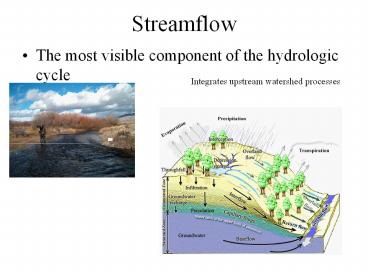Streamflow PowerPoint PPT Presentation
1 / 18
Title: Streamflow
1
Streamflow
- The most visible component of the hydrologic
cycle
Integrates upstream watershed processes
2
Streamflow
- We could discuss scales from ephemeral streams to
major rivers
3
Streamflow
- Watershed transforms a hyetograph into a
hydrograph
4
Streamflow
- Streamflow is the spatially and temporally
integrated response determined by - 1. Spatially and temporally variable input rates
Precipitation and Snowmelt - 2. The time required for each drop of the water
to travel from where it strikes the watershed
surface to the stream network - Hillslope
Hydrology - 3. The time required for water to travel in the
channel Channel flow
5
Streamflow
- We will focus on scales wherein the signals of
storm and watershed properties are evident not
big rivers
Primarilyhillslope control
Primarily channel control
6
Streamflow
- Our goal is to understand how landscape
properties interact with storm behavior to
produce streamflow, and to become familiar with
tools to predict .
7
Streamflow
- We will cover
- Hydrograph description
- What does hydrologic response look like?
- Flow processes
- Hillslope hydrology
- how does water get to a stream?
- Channel flow
- how do channels transform streamflow?
- Streamflow measurement
- Rainfall-runoff modeling
- How do we predict the response of streams to
water input events?
8
Storm Hydrograph Description
Crest, Peak
Rising limb
Recession, falling limb
Baseflow
Storm and landscape properties interact to
produce the shape of a hydrograph
9
Hydrograph Description
- Hydrographs can be described in many ways
- Timing Characteristics
- Recession
- Rainfall Runoff Ratios
- Hydrograph separation
10
Hydrograph Description
- Timing characteristics
Here is a hyetograph plotted over the resulting
hydrograph. By analyzing the shape and response
times we can investigate how the stream responds
to precipitation. Tp Duration of
precipitation. Tep Duration of effective
precipitation. Tr1 Time from first rainfall to
first rise in hydrograph. Tr2 Time from end of
rainfall to hydrograph peak Tr Duration of
hydrograph rise. Tlp Time from hyetograph
centroid to hydrograph peak. Tlc Time from
hyetograph centroid to hydrograph centroid. Tb
Time from initial rise to antecedent discharge.
Initial response Time lags Time base
11
Hydrograph Description
- Recession
Q(t) Q0e(-t/t)
Recession tends to follow an exponential
function tis controlled by how a watershed
drains
12
Hydrograph Description
- The runoff ratio ratio is the volume of storm
flow divided by the volume of water input - Weff/W, response factor
- Weff effective precipitation volume (depth)
- W total precipitation volume (depth)
Weff
Q
P
Time
time
13
Hydrograph Description
- Runoff ratio can be highly variable
- See figure 9-8 page 398
- See McNamara et al., 1998
14
Hydrograph Description
- The goal of hydrograph separation is to identify
the magnitudes of water sources in a hydrograph. - 2 approaches
Event flow versus base flow
Old water versus new water
Event flow
Q
Base flow
Time
time
Tells us the volume of response, Can be a mixture
of many sources
Tells us where the water came from event vs
pre-event
15
Hydrograph Separation
- Figure 8-38 illustrates 3 standard approaches to
separate event flow from base flow
Does 8-38b make any sense?
16
Hydrograph Separation
- 8-38b is a graphical technique that tells us the
source of water. Is it precip or groundwater that
is contributing to streamflow?
As different sources shut down the shape of the
recession changes and groundwater is the last
source. If we want to know Weff do we really
care what the source is?
The first paragraph on 396 is WRONG!!! Why?
Because the last line in that section is true.
THERE ARE TWO PURPOSES FOR CONDUCTING HYDROGRAPH
SEPARATIONS.
17
Hydrograph Separation
- It is sometimes desirable to know not only the
volume of runoff, but also the sources of runoff.
Why? The comments about the shortcomings of
graphical separation do apply here.
18
Old Water vs New Water

